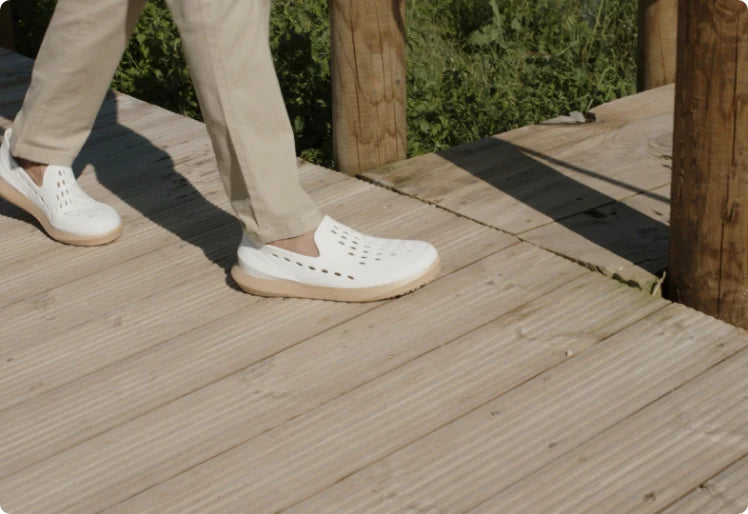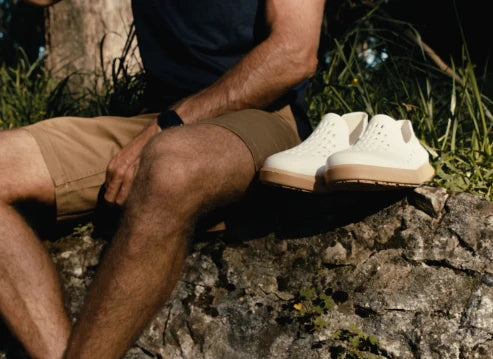Non-slip shoes, also known as work shoes with slip-resistant properties, are designed to prevent slips and falls in various workplace environments. These specialized shoes are essential for maintaining safety on the job, especially in industries like construction and food service where wet or oily surfaces are common.
Key Features of Non-Slip Shoes:
- Rubber Outsoles: The primary material used for their soles, rubber provides an excellent balance of flexibility and traction.
- Deep Tread Grooves: These grooves help channel water and debris away from the shoe's surface, enhancing grip.
- Circle Outsoles: Some designs feature circle-shaped lugs that offer 360-degree traction for multidirectional stability.
Investing in high-quality non-slip shoes is crucial for reducing the risk of workplace injuries. By increasing friction and improving stability, these shoes provide a safer working environment.
For those who frequently travel by air, it's important to consider comfortable footwear options. Long hours spent sitting, walking through terminals, and standing in security lines can take a toll on your feet if you're not wearing the right footwear. With that in mind, Strato Footwear offers a range of modern, sleek, and multipurpose shoes that strike the perfect balance between style and comfort.
The Science Behind Non-Slip Shoes: Understanding Slip Resistance
Non-slip shoes are extremely important for maintaining safety in the workplace, as they help people maintain their balance on different types of surfaces. The key to their effectiveness lies in their ability to provide slip resistance. In this article, we will delve into the science behind slip resistance and how friction plays a crucial role in keeping us safe.
How Slip Resistance Works
Slip resistance refers to the shoe's capacity to grip the ground and prevent slipping when walking on slippery surfaces. This feature is particularly essential in areas where spills, wet floors, or oily substances are frequently encountered. Here are some important points to understand about slip resistance:
- Traction Maintenance: Slip-resistant shoes are specifically designed to adjust to various surfaces, ensuring that the wearer maintains stability and does not lose their footing.
- Surface Interaction: The bottom part of non-slip shoes, also known as the outsole, comes into direct contact with the ground. It is designed in such a way that it creates a strong grip, making it harder for slips and falls to occur.
The Role of Friction
Friction can be defined as the force that opposes the motion of one surface over another. When it comes to non-slip shoes, friction plays a crucial role in preventing us from sliding. Here's how:
- Rubber Sole: One of the primary materials used for making outsoles slip-resistant is rubber. This material offers an excellent combination of flexibility and traction.
- Example: As you walk, the rubber outsoles of your shoes bend slightly, allowing for more contact with the ground and ultimately improving grip.
- Friction Enhancement:
- Micro-grooves: The presence of small grooves on the rubber sole increases the amount of surface area that comes into contact with the ground.
- Material Properties: The rough texture and flexibility of rubber significantly contribute to its ability to generate friction.
Understanding these factors helps us realize why non-slip footwear is absolutely essential in certain industries where the risk of accidents is high.
By paying attention to these important features, non-slip shoes ensure that workers can maintain their stability even on slippery surfaces, thereby reducing the likelihood of falls and injuries.
How Are Non-Slip Shoes Designed for Maximum Traction?
Non-slip shoes are meticulously designed to provide exceptional traction, especially in wet or oily environments. Let's explore the key components that make these shoes indispensable for safety.
1. Rubber Outsoles: The Foundation of Slip Resistance
Rubber outsoles are the cornerstone of slip-resistant footwear. Here's why rubber is the preferred material:
- Flexibility: Rubber offers an optimal balance of flexibility, allowing the shoe to adapt to various surfaces.
- Traction: The inherent roughness and stickiness of rubber increase friction, reducing the risk of slipping.
- Durability: Rubber outsoles can withstand wear and tear, maintaining their grip over time.
These properties make rubber outsoles a critical feature in non-slip shoes, ensuring they perform effectively across diverse conditions.
2. Tread Pattern: A Closer Look at Effective Traction Designs
The tread pattern on non-slip shoes plays a pivotal role in enhancing grip. Effective tread designs create channels that:
- Dispense Water: Channels allow water to escape from under the shoe, preventing hydroplaning on wet surfaces.
- Remove Debris: Grooves and patterns help push away dirt and debris, maintaining consistent contact with the ground.
An example of effective tread design is deep grooves that interlock with surface irregularities, providing stable footing even on slippery floors.
3. Innovative Feature Spotlight: Circle Outsoles for 360-Degree Traction
One unique design concept in non-slip footwear is the circle outsole. This innovative feature includes:
- Circle-Shaped Lugs: These lugs offer multidirectional stability, making it easier to maintain balance when moving in different directions.
- 360-Degree Traction: Circle outsoles provide a comprehensive grip, reducing slips regardless of how you step or turn.
This design ensures that users have reliable traction from all angles, significantly enhancing safety in dynamic work environments.
By integrating these elements—rubber outsoles, effective tread patterns, and innovative circle outsole designs—non-slip shoes deliver maximum traction and stability.
The Wide Application and Benefits of Non-Slip Shoes
Non-slip shoes are essential for maintaining safety in various work settings. They offer reliable traction and grip, reducing the risk of slips, trips, and falls. Beyond injury prevention, these shoes provide several advantages that contribute to a better working experience.
Essential Industries for Non-Slip Shoes
Non-slip shoes play a crucial role in workplace safety across various sectors. Key industries where these shoes are indispensable include:
- Construction Industry: Construction sites are often filled with hazards such as wet surfaces, loose debris, and uneven terrains. Non-slip shoes help workers maintain their footing, reducing the risk of slips and falls.
- Food Service Industry: Kitchens and dining areas can be prone to spills of liquids and grease. Slip-resistant footwear ensures that chefs, waitstaff, and cleaners can move swiftly and safely, even on slippery floors.
- Healthcare: Hospitals and clinics require staff to be on their feet for long periods while navigating potentially slick surfaces due to spilled fluids or cleaning products.
- Manufacturing: Factories often have oily or wet floors. Non-slip shoes provide the necessary grip to prevent accidents in such settings.
Beyond Injury Prevention
Wearing non-slip shoes offers more than just protection from injuries. Additional benefits include:
- Improved Confidence: Employees who wear non-slip shoes feel more secure in their movements. This confidence translates into better performance and fewer disruptions during their workday.
- Enhanced Productivity: When workers are not worried about slipping or falling, they can focus more on their tasks. This leads to higher efficiency and productivity levels.
- Comfort and Support: Many non-slip shoes are designed with ergonomic features to provide comfort during long shifts. Proper arch support and cushioning reduce fatigue, allowing employees to work longer without discomfort.
Real-world Impact
Examples of how non-slip shoes make a difference in daily operations:
“In our restaurant kitchen, investing in non-slip footwear has reduced slip incidents by 40%. It’s been a game-changer for our team's safety.” - Restaurant Manager
“On construction sites, the right footwear is as crucial as any other protective gear. Non-slip shoes have become standard issue for our crew.” - Construction Site Supervisor
Ensuring that employees across various industries wear appropriate non-slip footwear is a proactive step towards creating safer work environments. This investment not only safeguards employees but also enhances overall workplace efficiency and morale.
Maintaining Traction and Extending the Lifespan of Non-Slip Shoes
Ensuring your non-slip shoes remain effective requires proper care and maintenance. Here are some essential care tips to maintain their traction and extend their lifespan:
Regular Cleaning Routine for Maximum Traction
Maintaining clean outsoles is crucial for preserving the slip-resistant properties of your shoes.
- Daily Cleaning: Use a soft brush or cloth to remove loose dirt and debris from the outsole. This prevents buildup that can reduce grip.
- Deep Cleaning: Once a week, use warm soapy water and a stiff brush to scrub the outsoles thoroughly. Pay extra attention to the grooves in the tread pattern where dirt tends to accumulate.
- Dry Completely: After cleaning, ensure your shoes are completely dry before wearing them again. Moisture can affect both traction and comfort.
Essential Outsole Maintenance Techniques
Proper maintenance of the outsole material is key to prolonging the effectiveness of non-slip shoes.
- Avoid Extreme Temperatures: Exposure to excessive heat or cold can deteriorate the rubber material. Store your shoes in a cool, dry place away from direct sunlight and heat sources.
- Inspect Regularly: Check for signs of wear and tear, such as thinning tread patterns or cracks in the rubber. Replace your shoes if you notice significant damage that could compromise safety.
- Rotate Usage: If possible, have more than one pair of non-slip shoes and rotate their use. This allows each pair time to recover from daily wear, extending their overall lifespan.
By following these care tips, you can maintain optimal traction and ensure your non-slip shoes provide reliable performance in any work environment.
Conclusion
Prioritizing safety in the workplace is crucial, and investing in high-quality non-slip shoes plays a significant role in ensuring a secure working environment. Non-slip shoes are essential for:
Making the right choice in footwear can dramatically reduce the risk of accidents, particularly in industries such as construction and food service where slippery surfaces are common.
Ensuring your non-slip shoes meet recognized safety standards like ASTM International F1677 can give you peace of mind that they perform reliably in real-world conditions.
"Safety isn't expensive; it's priceless."
By equipping yourself with effective non-slip shoes, you take an essential step towards maintaining workplace safety. Choose wisely and take care of your footwear to enjoy long-lasting protection.




